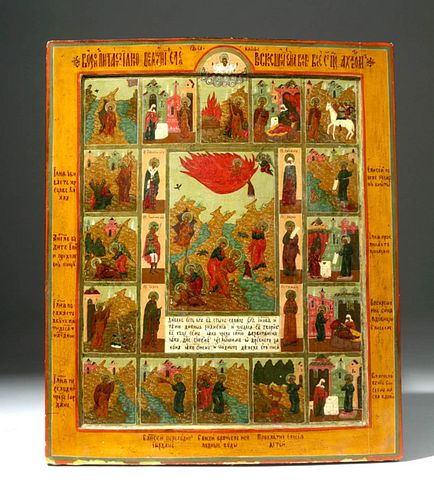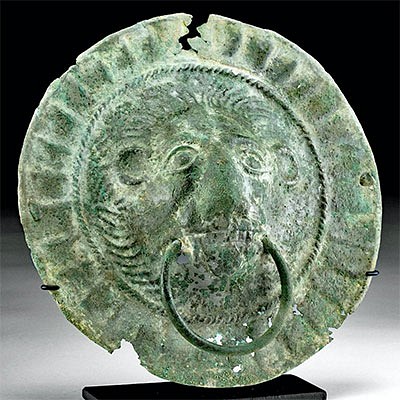19th C. Russian Icon - Fiery Ascent of Prophet Elijah
Lot 284a
About Seller
Artemis Fine Arts
686 S Taylor Ave, Ste 106
Louisville, CO 80027
United States
Selling antiquities, ancient and ethnographic art online since 1993, Artemis Gallery specializes in Classical Antiquities (Egyptian, Greek, Roman, Near Eastern), Asian, Pre-Columbian, African / Tribal / Oceanographic art. Our extensive inventory includes pottery, stone, metal, wood, glass and textil...Read more
Categories
Estimate:
$3,000 - $4,500
Absentee vs Live bid
Two ways to bid:
- Leave a max absentee bid and the platform will bid on your behalf up to your maximum bid during the live auction.
- Bid live during the auction and your bids will be submitted real-time to the auctioneer.
Bid Increments
| Price | Bid Increment |
|---|---|
| $0 | $25 |
| $300 | $50 |
| $1,000 | $100 |
| $2,000 | $250 |
| $5,000 | $500 |
| $10,000 | $1,000 |
| $20,000 | $2,500 |
| $50,000 | $5,000 |
| $100,000 | $10,000 |
| $200,000 | $20,000 |
About Auction
By Artemis Fine Arts
Oct 14, 2021
Set Reminder
2021-10-14 10:00:00
2021-10-14 10:00:00
America/New_York
Bidsquare
Bidsquare : CLEARANCE | Ancient & Ethnographic Art
https://www.bidsquare.com/auctions/artemis-gallery/clearance-ancient-ethnographic-art-7705
Kick off fall with our clearance sale featuring discounted pricing and many new items! Asian art, Classical antiquities from Egypt, Greece, Italy, and the Near East...plus Pre-Columbian, Tribal, Russian Icons & Enamelware, Spanish Colonial, Fine Art, Fossils, more! Starting prices have been reduced Artemis Fine Arts info@artemisfinearts.com
Kick off fall with our clearance sale featuring discounted pricing and many new items! Asian art, Classical antiquities from Egypt, Greece, Italy, and the Near East...plus Pre-Columbian, Tribal, Russian Icons & Enamelware, Spanish Colonial, Fine Art, Fossils, more! Starting prices have been reduced Artemis Fine Arts info@artemisfinearts.com
- Lot Description
**Originally Listed At $5500**
Eastern Europe, Russia, ca. late 19th century CE. Finely rendered in egg tempera, gold leaf, and gesso on wood, a breathtaking icon honoring the Prophet Elijah who, as depicted in the central panel, rides into heaven on a chariot drawn by celestial horses under the fearful watch of his disciple Elisha (Eliseus). Other vignettes of the central panel include: Elijah sitting in a desert cave after predicting a famine as a crow approaches to feed him; the angel appearing to Elijah later on, after he won the challenge against the priests of Baal in the king's court and fled to the desert once again, and Elijah separating the waters of the Jordan River. In the sixteen bordering images are pictorial accounts of Elijah's story in concordance with I Kings 17-19. The six slender panels to the left and right of the central image depict saints (left from top to bottom are Basil, John the Warrior, and Sergei of Radonezh; right includes St. Mark, St. Stephen, and Natalia). Many calligraphic passages narrate the scenes. Size: 14.75" W x 17.75" H (37.5 cm x 45.1 cm).
In Russia, according to scholar Alfredo Tradigo, Elijah replaced Perun, the Slavic deity of thunder, who also rode into heaven on a chariot of fire drawn by otherworldly horses. During the reign of King Ahab and Queen Jezebel, in the decade between 860 and 850 BCE, Elijah told his prophesies. Following his prediction of a famine, Elijah took refuge in a desert cave. There, a crow fed him, by order of the Lord, bread in the morning (visible in his left hand) and meat at night (shown being delivered by the crow to Elijah's upraised right hand). He then returned to the king's court and won a challenge putting 400 priests of Baal to the sword. Following this, he fled to the desert and prayed for death. However, an angel appeared and brought him food. The bread he ate strengthened him (Church Fathers interpreted this as a prefiguration of the Eucharist) and he walked for forty days until reaching Horeb, god's mountain. Here, he miraculously found God, "not in the wind or the earthquake or the fire, but in a 'small voice.'" (Alfredo Tradigo, "Icons and Saints of the Eastern Orthodox Church," J. Paul Getty Museum, Los Angeles, 2006, p. 81.)
Icons were some of the first religious artworks brought to Russia from Byzantium. These sacred pictures reached a high point in the Byzantine era, however, the Russians brought their own style to the art of the icon. Icons were initially created for use in churches and processions. In time they became smaller and were used increasingly within households. To this day they remain an important form of visual culture in Russia's orthodox religious community.
Icons (icon means "image" in Greek) are sacred objects within the Eastern Orthodox Christian tradition. Found in homes as well as churches, these painted images depict holy persons and saints as well as illustrate scenes from the Scriptures. Icons are not worshiped, but are instead venerated for their ability to focus the power of an individual's prayer to God. As such they are truly "windows into heaven."
Provenance: private Francis & Lilly Robicsek Collection, Charlotte, North Carolina, USA, acquired second half of the 20th century
All items legal to buy/sell under U.S. Statute covering cultural patrimony Code 2600, CHAPTER 14, and are guaranteed to be as described or your money back.
A Certificate of Authenticity will accompany all winning bids.
PLEASE NOTE: Due to recent increases of shipments being seized by Australian & German customs (even for items with pre-UNESCO provenance), we will no longer ship most antiquities and ancient Chinese art to Australia & Germany. For categories of items that are acceptable to ship to Australia or Germany, please contact us directly or work with your local customs brokerage firm.
Display stands not described as included/custom in the item description are for photography purposes only and will not be included with the item upon shipping.
#119532Expected surface wear and minor paint and gold leaf losses commensurate with age. Icon also shows nice craquelure and age fissures. Verso is missing back slats and an adhesive was used to keep the two wood panels from which this icon was originally made together. There is also an incised inscription on the verso.Condition
- Shipping Info
-
All shipping is handled in-house for your convenience. Your invoice from Artemis Gallery will include shipping calculation instructions. If in doubt, please inquire BEFORE bidding for estimated shipping costs for individual items.
-
- Buyer's Premium



 EUR
EUR CAD
CAD AUD
AUD GBP
GBP MXN
MXN HKD
HKD CNY
CNY MYR
MYR SEK
SEK SGD
SGD CHF
CHF THB
THB




















